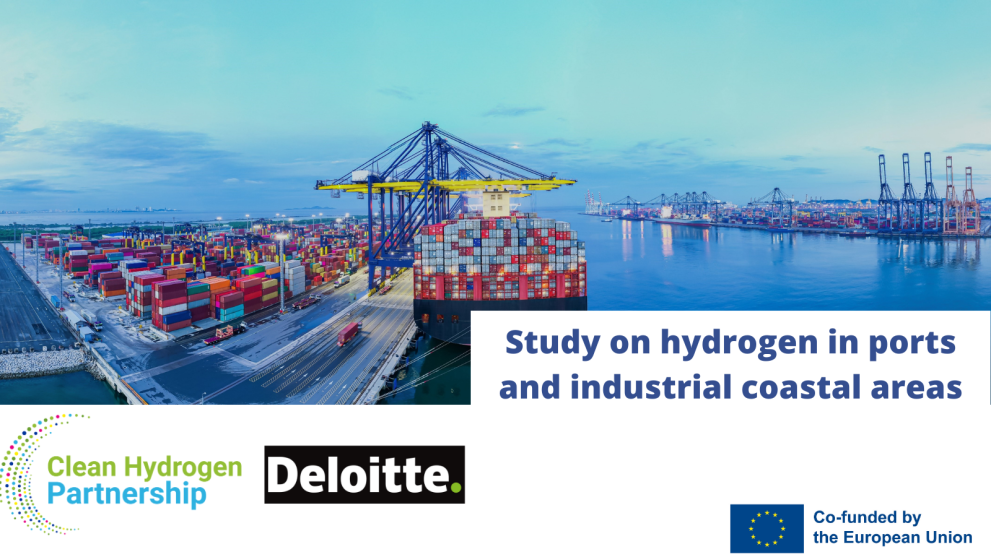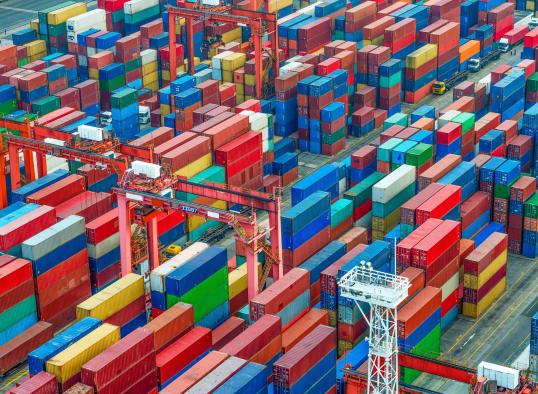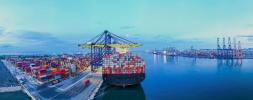
Brussels, Belgium – 30 March 2023 – The European Union needs to radically accelerate the deployment of hydrogen production, import terminal, reconversion, storage, transportation, and consumption infrastructure capacity in port ecosystems in order to meet its 2030 renewable hydrogen targets, shows new study on hydrogen in ports and industrial coastal areas.
Port ecosystems are expected to play a crucial role in the expansion of the European hydrogen market through 2050. First, as energy transit hubs facilitating the import of hydrogen and its distribution, and second, as investors in dedicated infrastructure to produce, import, store, and distribute hydrogen to multiple end-users in the wider port areas and/or into the hinterland.
Hydrogen, especially of renewable origin (i.e., green hydrogen), has consolidated during the past years its prominent position in the EU's energy transition policies and is expected to be critical in substituting fossil gas, coal, and oil in hard-to-decarbonize industries (e.g., refineries, ammonia, steel, chemicals) and transportation (i.e., heavy duty road freight, shipping, aviation).
According to the REPowerEU Plan the “development of port infrastructure and their connection to both industrial and transport users in the vicinity will be of critical importance” for increasing the demand for renewable hydrogen in Europe to 20 million tonnes per year in 2030. REPowerEU includes the ambitious target of 10 million tonnes of renewable hydrogen production in the EU and 10 million tonnes of renewable hydrogen imports by 2030.
Using a scenario-based approach, Deloitte Belgium Energy and Climate practice carried out for the Clean Hydrogen Partnership an extensive study that provides detailed outlooks of the potential hydrogen demand and supply in European ports and coastal areas in 2030, 2040 and 2050, along with the required hydrogen value chain infrastructure and a no-regrets investment roadmap for the development of hydrogen activities and infrastructure in the vicinity of ports. The report also provides an overview of the various possible roles that a port could fulfil in Europe's future hydrogen economy.
The key message of the study is that achieving REPowerEU's ambitious target and continuing to expand the European hydrogen market through 2050 requires accelerated investment in dedicated infrastructure in port areas to deliver hydrogen to multiple end-users in the wider port areas and/or into the hinterland.
Up to 42% (22 Mt, or 730 TWh) of total hydrogen demand in the EU in 2050 could be located in port areas.
Overall, by 2050, in the most ambitious market-driven demand scenarios, annual hydrogen demand across the EU is expected to increase significantly, up to about 53 Mt (or 1,764 TWh), with 42% (22 Mt, or 730 TWh) of this demand being in port areas.
Bart Biebuyck, Executive Director of the Clean Hydrogen Partnership, said: “Accelerating the hydrogen infrastructure in ports and their capacity as hydrogen transit hubs is an important step towards building the hydrogen economy and our study clearly shows it. With ports and industrial coastal areas expected to account for 42% of the annual hydrogen demand across the EU we need to work together for the development of a 'European Hydrogen Ports Roadmap' that can unlock the ports areas’ full decarbonisation potential”.
Hydrogen demand in European port areas is expected to be mainly driven by industries and the international shipping sector (accounting for respectively 42% and 31% of total demand in port areas in 2050).
At the EU level, the demand scenario aligned with the market development pathway envisioned by the REPowerEU plan a considerable ramp-up (+174%) from the most ambitious market-driven scenario for 2030 (11.6 Mt). This extremely fast and large uptake of green and, to a lesser extent, blue hydrogen (see note below) consumption in port areas as a substitution of fossil-based fuels has the potential to lead to significant CO2-eq abatement in 2050 (up to 360 Mt of CO2-eq, or 8% of total European GHG emissions in 2019) as well as additional environmental benefits (e.g., reduction of toxic atmospheric emissions, water pollutants, solid waste, and noise emissions).
On the supply side, ports are expected to play a key role as energy transit hubs in facilitating the import of hydrogen and subsequent transportation to multiple end-users in the wider port areas and/or into the hinterland.
To match the future demand of hydrogen in 2030, 2040 and 2050, Deloitte’s cost optimization model, which strived for economic optimum based on Levelized Cost of Hydrogen (LCOH), concludes that the share of hydrogen import in total hydrogen consumption in the EU could range between 25% and 70% in 2050, depending mostly on the ability of Member States to very rapidly increase the annual rate of deployment of local renewable energy production capacities (solar PV and onshore and offshore wind) over the next years and decades.
In all scenarios, the largest hydrogen demand cluster (Belgium, Netherlands, Denmark, and North of Germany) is expected to heavily rely on green and blue hydrogen import (between 40% and 80% of total hydrogen consumption), mainly coming from North Africa (Morocco, Egypt, Algeria), the Middle East (Oman, Saudi Arabia, Qatar) and even further (e.g., such as Australia). Some intra-European hydrogen exports and imports can also be expected (e.g. from Spain to France).
Finally, to match future hydrogen supply and demand, the required production, import terminal, conversion, storage, transportation, and consumption (e.g., refueling stations and bunkering) infrastructure capacities to develop both inside and outside of ports and associated investment costs are provided for each scenario, demand cluster, and timeframe.
A unique feature of this study is that specific results for each of the 427 European seaports and inland ports in scope on future hydrogen demand, supply, related CO2eq abatement and required infrastructures for each timeframe (2030, 2040 and 2050) and modelled scenarios can be freely accessed in an online dynamic dashboard accompanying this report.
The dashboard provides clear insights to each port authorities and other port-related stakeholders on the potential for hydrogen demand in their port ecosystem and related CO2 abatement, from where and at what cost this demand could be supplied, and which infrastructures and association investments could be required to unlock the full potential of the hydrogen economy in each individual ports.
Stakeholders interested in accessing the dashboard can formulate a request by sending an email to Deloitte - Sofie De Brabander sdebrabander deloitte [dot] com (sdebrabander[at]deloitte[dot]com)
deloitte [dot] com (sdebrabander[at]deloitte[dot]com)
The full report as well as its Executive Summary can be downloaded here.
Key insights from the report are available as well below.
About the Study on hydrogen in ports and industrial coastal areas
The ‘Study on hydrogen in ports and industrial coastal areas’ comprises several phases, with this report being the first in a series of three reports that will all be released by the end of 2023.
The second report, expected to be released in early spring, will aim to inform relevant port related stakeholders (including policymakers) on the required non-technical (policy, regulatory, governance, strategic, etc.) enablers, areas of priority for research and innovation projects and required safety regulations, codes, and standards for the timely development of hydrogen related activities and infrastructures in EU port ecosystems.
The third report, expected by the end of the year, will examine several case studies highlighting the techno-economic feasibility of developing a range of hydrogen-related activities and infrastructures in the vicinity of ports.
In parallel, the organization of multiple European Hydrogen Ports Network events all along the duration of this study help create impetus for the main European representatives of the port ecosystem to come together, exchange, connect and take a long-term perspective on hydrogen take-up in European ports.
These activities have the end-goal to enable the creation of a 'European Hydrogen Ports Roadmap'.
Key insights from the study (EU scope)
- Mainly driven by industries and the international shipping sectordemand for clean hydrogen in the vicinity of European ports could reach 22 Mt (730 TWh), or 42% of total hydrogen demand in the EU expected in 2050. This would represent a six-fold increase compared to the current demand for hydrogen near European ports (3.8 Mt, or 126 TWh).
- This extremely fast and large uptake of clean hydrogen consumption in port areas as a substitution of unabated fossil-based fuels has the potential to lead to up to 360 Mt of CO2-eq abatement in 2050 (or 8% of total European GHG emissions in 2019) as well as additional environmental benefits (e.g., reduction of toxic atmospheric emissions, water pollutants, solid waste, and noise emissions).
- On the supply side, with the share of hydrogen import in total hydrogen consumption in the EU expected to range between 25% and 70% in 2050, depending mostly on the ability of Member States to very rapidly increase the annual rate of deployment of local renewable energy production capacities over the next decades, EU ports are expected to play a key role as energy transit hubs in facilitating the import of hydrogen and subsequent transportation to multiple end-users in the wider port areas and/or into the hinterland.
- Using Deloitte’s cost optimization model, the North-western European region (Belgium, Netherlands, Denmark, and North of Germany) is expected overall to heavily rely on hydrogen import (between 40% and 80% of total hydrogen consumption), mainly coming from North Africa (Morocco, Egypt, Algeria), the Middle East (Oman, Saudi Arabia, Qatar) and even further (e.g., such as Australia).
- Creating and rapidly expanding the European clean hydrogen market through 2050 requires accelerated investment in production, import terminal, conversion, storage, transportation, and consumption (e.g., refueling stations and bunkering) infrastructure capacities in port areas to deliver hydrogen to multiple end-users in the wider port areas and/or into the hinterland.
- At the EU level, the demand scenario aligned with the market development pathway envisioned by the REPowerEU plan (target of 20 Mt of green hydrogen consumption in 2030, of which 10 Mt imported from non-EU countries) represents a considerable ramp-up (+174%) from the most ambitious market-driven scenario for 2030 (11.6 Mt) and is associated with a significant acceleration of investment in dedicated infrastructure in port areas.
- As hydrogen demand hubs and transit corridors, port ecosystems are uniquely positioned to harness the opportunities arising from the nascent European hydrogen economy, with potential to create a competitive advantage. A cascading set of strategic choices, from "aspiration" to "where to play", "how to win" and "how to configure", will help each port ecosystem define the right strategic directions in a well-structured way.
Details
- Publication date
- 30 March 2023
- Author
- Clean Hydrogen Joint Undertaking


